Almaleea is a genus of perennial shrubs from the legume family Fabaceae native to Australia.

Joseph Henry Maiden was a botanist who made a major contribution to knowledge of the Australian flora, especially the genus Eucalyptus. This botanist is denoted by the author abbreviation Maiden when citing a botanical name.
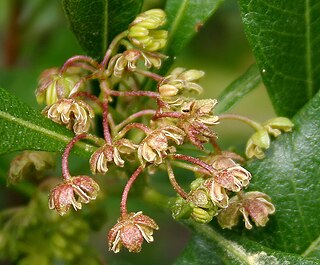
Dodonaea viscosa is a species of flowering plant in the soapberry family, Sapindaceae, that has a cosmopolitan distribution in tropical, subtropical and warm temperate regions of Africa, the Americas, southern Asia and Australasia.

Alloxylon is a genus of four species in the family Proteaceae of mainly small to medium-sized trees. They are native to the eastern coast of Australia, with one species, A. brachycarpum found in New Guinea and the Aru Islands. The genus is a relatively new creation, being split off from Oreocallis. The name is derived from Ancient Greek allo- "other" or "strange" and xylon or "wood" due to their unusual cell architecture compared with the related genera Telopea and Oreocallis. In Australia, they are known as tree waratahs due to similarities in the inflorescences between them and the closely related Telopea.

Dodonaea is a genus of about 70 species of flowering plants, often known as hop-bushes, in the soapberry family, Sapindaceae. It has a cosmopolitan distribution in tropical, subtropical and warm temperate regions of Africa, the Americas, southern Asia and Australasia. By far the highest species diversity is in Australia. The genus is named after Rembert Dodoens, traditionally known as 'Dodonaeus'.
Rupicola is a small genus of flowering plants in the family Ericaceae. The species are endemic to New South Wales in Australia.
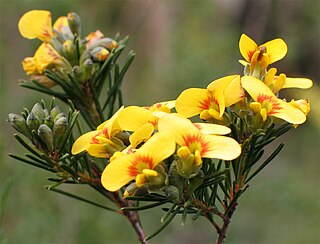
Dillwynia is a plant genus of the family Fabaceae. They are endemic to Australia, occurring in all states except the Northern Territory.
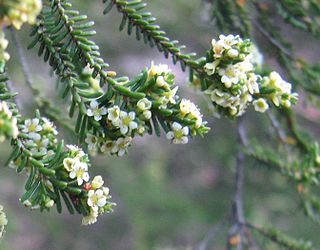
Micromyrtus is a genus of shrubs, in the family Myrtaceae, described as a genus in 1865. The entire genus is endemic to Australia.

Stylidium debile, commonly known as the frail triggerplant, is a carnivorous, dicotyledonous plant that belongs to the genus Stylidium. S. debile is endemic to coastal areas in Queensland and New South Wales, Australia.

Euryomyrtus is a genus of shrubs, in the family Myrtaceae, all of which are endemic to Australia.

Themeda is a genus of plants in the grass family native to Asia, Africa, Australia, and Papuasia. There are about 18 to 26 species, many of which are native to Southeast Asia.

Rulingia is a genus of flowering plants native to Australia and Madagascar. In 2011, all species were transferred to Commersonia with the exception of Rulingia cuneata, R. loxophylla, R.luteiflora and R. procumbens which have been transferred to the new genus Androcalva.
Uranthoecium is a genus of plants in the grass family. The only known species is Uranthoecium truncatum, native to Queensland, New South Wales, South Australia, Northern Territory, and Western Australia. A common name is flat-stem grass.
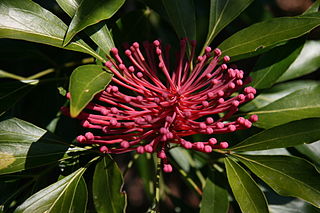
Alloxylon pinnatum, known as Dorrigo waratah, is a tree of the family Proteaceae found in warm-temperate rainforest of south-east Queensland and northern New South Wales in eastern Australia. It has shiny green leaves that are either pinnate (lobed) and up to 30 cm (12 in) long, or lanceolate (spear-shaped) and up to 15 cm (5.9 in) long. The prominent pinkish-red flower heads, known as inflorescences, appear in spring and summer; these are made up of 50 to 140 individual flowers arranged in corymb or raceme. These are followed by rectangular woody seed pods, which bear two rows of winged seeds.
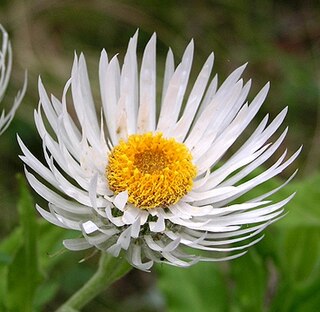
Coronidium boormanii is a perennial herbaceous shrub in the family Asteraceae found in Australia. Previously known as Helichrysum boormanii, it was given its new name in 2008.

Persoonia hirsuta, commonly known as the hairy geebung or hairy persoonia, is a plant in the family Proteaceae and is endemic to eastern New South Wales. It is a hairy, spreading to low-lying shrub with linear, lance-shaped or spatula-shaped leaves and yellow or orange flowers arranged singly or in groups of up to ten on a rachis up to 20 mm (0.79 in) long.

Daniel Ludwig Ernst Betche was a German-Australian horticulturist and botanist.
Dodonaea filifolia, commonly known as thread-leaved hop-bush, is a species of shrub endemic to New South Wales, Queensland, South Australia, Western Australia, and the Northern Territory. Its fruit is red, suffused with yellow, and grows from September to December.

Goodenia dimorpha is a species of flowering plant in the family Goodeniaceae and is endemic to the Sydney region. It is an erect herb with adventitious roots, linear to egg-shaped leaves, mostly at the base of the plant, and panicles of yellow flowers.














